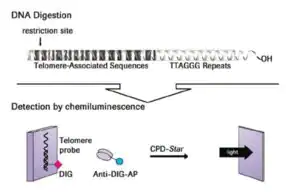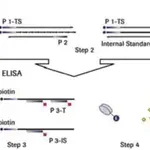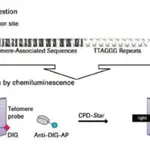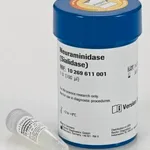
Merck TeloTAGGG Telomere Length Assay
✨AI 추천 연관 상품
AI가 분석한 이 상품과 연관된 추천 상품들을 확인해보세요
연관 상품을 찾고 있습니다...
Telo_TAGGG_™ Telomere Length Assay
sufficient for ≤50 reactions, kit of 1 (15 components), suitable for cell culture
telomere
Quality Level
사용
sufficient for ≤50 reactions
포장
kit of 1 (15 components)
manufacturer/tradename
Roche
technique(s)
cell culture | mammalian: suitable
배송 상태
dry ice
저장 온도
−20°C
Telomeres, the specialized DNA protein structures located at the end of eukaryotic chromosomes, consist of small, tandemly repeated DNA sequences. Numerous telomere sequences have been identified that display very few sequence variations, even between phylogenetically divergent organisms such as Tetrahymena (sequence: TTGGGG) and humans (sequence: TTAGGG).
Because DNA polymerase is unable to replicate the very ends of linear DNA, it was suggested that chromosomal ends progressively shorten with each replication cycle (called the “end-replication problem”). This phenomenon, which has been demonstrated in vitro and in vivo, seems to be linked to the limited proliferative capacity of normal somatic cells (“mitotic clock”). Since germ-line cells, stem cells, and tumor cells all exhibit a prolonged or even infinite life span, it was suggested that these cells must possess a particular mechanism for maintaining telomere length.
Maintaining stable telomere length is associated with the activation of telomerase. This enzyme is a ribonucleoprotein that compensates for the loss of telomeric DNA by adding repeat sequences to the chromosome ends, using its intrinsic RNA component as a template for DNA synthesis.
Telomeres play an essential role in the stable maintenance of eukaryotic chromosomes within a cell by specifically binding to structural proteins. These proteins cap the ends of linear chromosomes, preventing nucleolytic degradation, end-to-end fusion, irregular recombination, and other events that are normally lethal to a cell.
Analysis of telomere length in research samples of human peripheral blood mononuclear cells reveals that telomere length decreases with increased age in the donor, reflecting the replicative history of those cells. In several disorders (e.g., Down′s syndrome, ataxia telangiectasia, and HIV infection), accelerated telomere loss has been described, suggesting the reduction in telomere length may be related to the immune dysfunction associated with these disorders. This kit is intended to increase scientific knowledge about these relationships.
Assay time: Approximately 18 hours
Sample material: Cell cultures and other biological samples
Nonradioactive chemiluminescent assay to determine telomere length.
🏷️Merck Sigma 상품 둘러보기
동일 브랜드의 다른 상품들을 확인해보세요
배송/결제/교환/반품 안내
배송 정보
| 기본 배송비 |
| 교환/반품 배송비 |
|
|---|---|---|---|
| 착불 배송비 |
| ||
| 교환/반품 배송비 |
| ||
결제 및 환불 안내
| 결제수단 |
|
|---|---|
| 취소 |
|
| 반품 |
|
| 환급 |
|
교환 및 반품 접수
| 교환 및 반품 접수 기한 |
|
|---|---|
| 교환 및 반품 접수가 가능한 경우 |
|
| 교환 및 반품 접수가 불가능한 경우 |
|
교환 및 반품 신청
| 교환 절차 |
|
|---|---|
| 반품 절차 |
|





